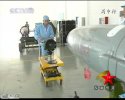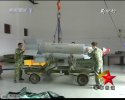A video produced to celebrate the recent
achievements of the China Flight
Test Establishment (CFTE) reveals
a wealth of evidence for new Chinese
weaponsprogrammesandthepaceof
weapons systems development by the People's
Liberation ArmyAir Force (PLAAF).
The official footage, which has now appeared
on the internet, shows an entirely new class of
air-to-surface missiles, airborne launch trials
of the Kh-31 high-speed anti-radiation missile
(ARM) and the PL-12 active radar beyond-visual-
range air-to-air missile (BVRAAM) , heavy
air-to-surface loads for the Chengdu J-10 and
Shenyang J-11B fighters, plus extensive test and
development activity with virtually every frontline
combat aircraft in Chinese service.
Most intriguing is a new missile design
believed to be designated KD-88.A few blurred
images of a weapon labelled KD-88 have been
seen prior to this but the CFTE film shows two
distinct versions being trialled by Xian JH-7A
attack aircraft. The missile is roughly 3.5 m long
and powered by a small turbojet/turbofan engine
with an underslung intake. Two different seeker
types are fitted – one appears to be electro-optical
(EO, potentially an imaging infrared seeker)
while the other is either an active radar seeker or
a passive RF-homing seeker for the defence suppression
mission.
JH-7As carry the KD-88 together with an
unidentified pod under its centre fuselage. This
pod is tipped with two di-electric fairings pointing
to its use as an emitter locator to cue anARM
version of the KD-88. However, it may also
function asadatalink to provide man-in-the-loop
guidance over extended ranges for the EO-seeker
KD-88 variant.
Also shown alongside the two KD-88 weapons
is what appears to be an air-launched YJ-8K
(C-801) anti-ship missile fitted with a new turbojet
engine. This is not the same as the much larger
C-802K weapon.
Another important development is the launch
of what is almost certainly a Chinese-built
Kh-31P (AS-17 %Krypton&) ramjet-powered
ARM by a JH-7. China is believed to have
launched a national programme to build Kh-
31s that was so extensive it consumed most of
the industrial resources at the missile's Russian
designers and developers, leaving the original
manufacturers (Soyuz-Turayevo and Zvezda-
Strela) unable to continue production in Russia.
Several test launches of the PL-12 (SD-10)
BVRAAM are shown, all using the Shenyang
J-11B (licence-built Su-27SK). The PL-12 is
now in operational service on both the J-11B
and the J-10, marking a major achievement for
China&smissile industry.
J-11Bs and J-10s are also shown carrying (and
in some cases delivering) sizeable bomb loads,
proving that they are true multirole aircraft. The
emergence of the JH-7A as both a precisionguided
munitions carrier and now a platform for
standoff weapons is significant. Furthermore,
with the Kh-31P (local designation YJ-91) and
perhaps an ARM version of the KD-88 the JH-
7A is functioning as a dedicated suppression of
enemy air defences (SEAD) aircraft–anentirely
new capability for the PLAAF.
The resources and facilities allocated to the
CFTE are very extensive by Western standards.
The video shows a test fleet of dozens of aircraft
based at least two sprawling air bases. The commentary
notes that the CFTE has conducted
flight testing on 36 different types of aircraft and
28 types of aero-engines.



